The Samsung Galaxy Tab S7 was one of the best Android tablets at the time it was released and was a decent iPad rival for anyone looking for an Android slab. The tablet received an upgrade this year in the form of the Samsung Galaxy Tab S8. While the display size remains the same, Samsung claims to have made improvements in the newer version — but is the newer model worth buying? Here’s a Samsung Galaxy Tab S8 versus Galaxy Tab S7 comparison to help you decide if the Galaxy Tab S8 is worth upgrading for or whether you can save money by grabbing the older model.
Specs
| Samsung Galaxy Tab S8 | Samsung Galaxy Tab S7 | |
| Size | 253.8 x 165.3 x 6.3mm (9.99 x 6.51 x 0.25 inches) | 253.8 x 165.3 x 6.3mm (9.99 x 6.51 x 0.25 inches) |
| Weight | Wi-Fi: 503 grams (17.74 ounces)
LTE: 507 grams (17.88 ounces) |
Wi-Fi: 498 grams (17.56 ounces)
LTE: 500 grams (17.63 ounces) |
| Screen size | 11-inch LCD | 11-inch LCD |
| Screen resolution | 2560 x 1600 pixels (274 pixels per inch) | 2560 x 1600 pixels (274 ppi) |
| Operating system | Android 12, OneUI 4.1 | Upgradable to |
| Storage space | 128GB, 256GB | 128GB, 256GB |
| MicroSD card slot | Yes | Yes |
| Processor | Qualcomm SM8450 Snapdragon 8 Gen 1 | Qualcomm Snapdragon 865 |
| RAM | 8GB, 12GB | 6GB, 8GB |
| Camera | Dual 13-megapixel wide and 6MP ultrawide rear, 12MP front | Dual 13MP wide and 5MP ultrawide rear, 8MP front |
| Video | 1080p at 30 fps | |
| Bluetooth version | Bluetooth 5.2 | Bluetooth 5.0 |
| Ports | USB-C | USB-C |
| Fingerprint sensor | Yes, side-mounted | Yes, side-mounted |
| Water resistance | No | No |
| Battery | 8,000mAh | 8,000mAh |
| App marketplace | Google Play Store | Google Play Store |
| Network support | All major carriers (cellular version only) | All major carriers (cellular version only) |
| Colors | Graphite, silver, Pink Gold | Black, bronze, silver, navy |
| Price | $699 | $699 |
| Buy from | Samsung | Samsung |
| Review score | Hands-on | Comparison |
Design and display
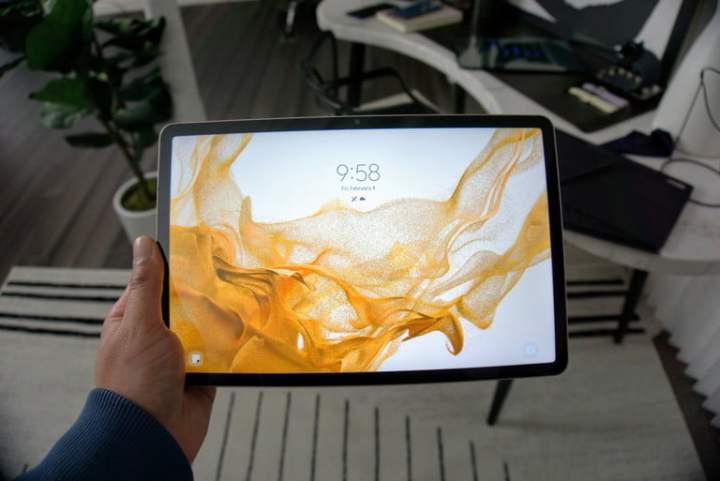
Both Samsung Galaxy Tab S7 and the new Galaxy Tab S8 sport a similar design, which means you get a tidy edge-to-edge display with narrow bezels. On the rear, you’ll see a black magnetic strip used to dock the S-Pen, which is included in the box.
The Galaxy Tab S7 featured an 11-inch LCD with a resolution of 2560 x 1600, DCI-P3 color range, and a 120Hz refresh rate. In use, these numbers translate to a color-rich, vivid, and bright experience. Plus, the 16:10 aspect ratio makes for a great video consumption experience. The display is the same on the Galaxy Tab S8, so if your usage includes a lot of in-hand reading, both these devices will serve you well.
You also get Low Blue Light certification on both devices that helps to reduce eye strain. The Galaxy Tab S7’s display was a bit underwhelming in direct sunlight, and you can probably expect the same on the Tab S8. Both tablets come with AKG-tuned quad speakers that support Dolby Atmos, which are loud and have clear sound — making for an enjoyable media consumption experience. That said, if you are OK with a larger size and want an AMOLED display, you should look at the Plus variant for both generations.
Both devices are housed in aluminum, giving them a fair amount of durability. However, neither comes with an IP rating, so it’s best to keep them away from water and not take them to the beach with you. Both devices offer a side-mounted fingerprint sensor for biometric authentication.
These devices have a lot in common, which means this category is a tie.
Winner: Tie
Performance, battery life, and charging
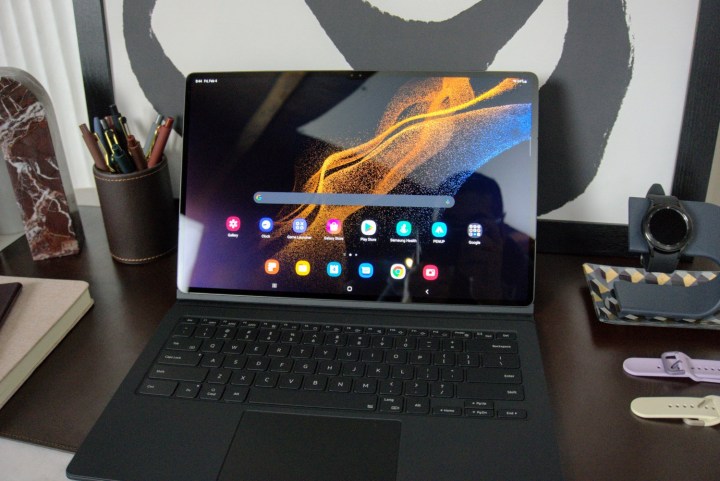
The Galaxy Tab S7 is powered by the Snapdragon 865 Plus SoC, which is paired with Adreno 650 GPU. This combination should mean it’s capable of running the latest 3D games without a hitch, and even the base model with 6GB of
The Galaxy Tab S8 comes equipped with the latest Snapdragon 8 Gen 1 SoC, coupled with 8GB or 12GB
Both the Galaxy Tab S7 and Tab S8 pack an 8,000mAh battery with support for 45W fast charging. Samsung claims this can recharge from zero to 100% in 80 minutes, but the company doesn’t bundle a 45W charger in the box — and you only get a 15W charger with the Galaxy Tab S7. Regular use, such as reading on Kindle, browsing on Chrome, watching YouTube, and bingeing your favorite show can all be done on a single charge.
While the Tab S7 is still plenty powerful, the Samsung Galaxy Tab S8 has more
Winner: Samsung Galaxy Tab S8
Camera
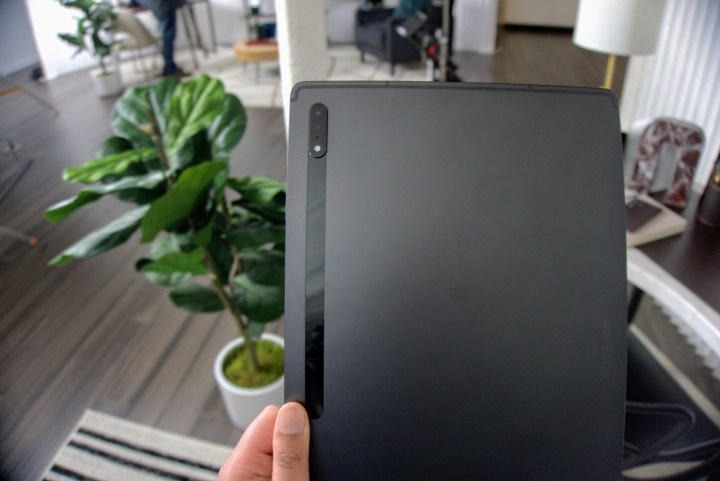
On the optics front, the Tab S7 sports a 13MP and 5MP dual-camera setup, whereas the Galaxy Tab S8 comes with 13MP and 6MP dual rear cameras. The front of the Tab S8 has a 12MP selfie shooter, while there’s an 8MP sensor on the Galaxy Tab S7.
The Galaxy Tab S7 gave us good skin tones in video calls with the front camera, and we expect the Tab S8 to continue in those footsteps with an even better lens on the front. On the other hand, the primary rear camera performed well, but the 5MP ultrawide shooter had trouble capturing details. We expect Samsung to have amended this with the Galaxy Tab S8. Both are perfectly capable of regular usage that includes capturing and scanning documents, whereas the front camera performs well in video calls and leaves nothing to complain about.
It’s tough to make a call here, as we haven’t had too much time with the Tab S8 yet. However, we’re giving the benefit of the doubt to the Galaxy Tab S8’s bigger numbers.
Winner: Samsung Galaxy Tab S8
Software and updates
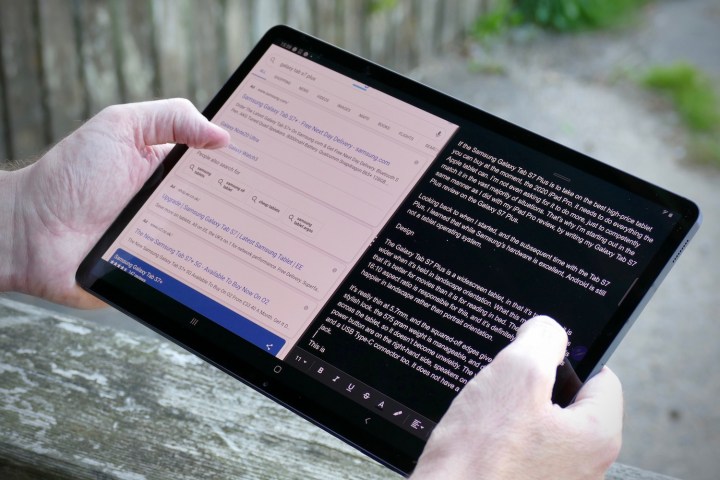
The Samsung Galaxy Tab S7 shipped with OneUI 2.5 built on top of
While Samsung was promising three years of
Aside from this, you get the much-appreciated Samsung DeX platform on both devices. It provides a PC-like environment for the tablets and is either automatically toggled when you attach a keyboard or it can be enabled from the notification menu. You also get support for wireless DeX that lets you transfer your screen to a Samsung smart TV display.
With a longer period of updates, the Galaxy Tab S8 wins here.
Winner: Samsung Galaxy Tab S8
Special features
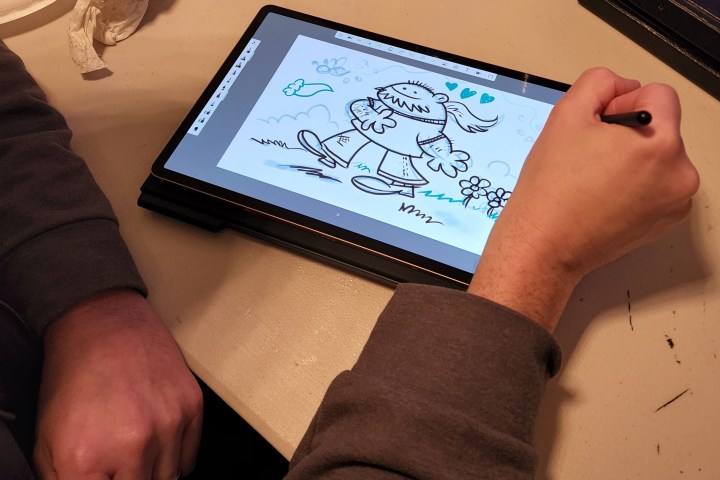
Both the Galaxy Tab S8 and Tab S7 ship with an S Pen, which has low latency, and when coupled with the 120Hz refresh rate, makes the Microsoft Surface Pen seem ordinary. You get features like Air Actions, which can access fast shortcuts and which you can use on any screen or app.
There’s also an optional keyboard accessory that packs a back cover to double as a stand for the tablet. The keyboard comes with function keys on the top. Overall, the keys are well spaced out with good key travel. However, there is no backlight, so you will likely struggle to use it in the dark. Plus, the lap-ability is poor. It will wobble when you try to use the tablet as a laptop on your lap. If you are working on a table, it will work just fine. As for the trackpad, it is of decent size and easy to use.
These two tablets have very similar features, so this is a tie.
Winner: Tie
Price and availability
The Samsung Galaxy Tab S8 starts at $699 for the 128GB model and bumps up to $779 for the 256GB version. It can be purchased from Samsung and will be supported by AT&T and T-Mobile in the near future. Plus, it is stocked by most major electronics retailers.
By contrast, the Samsung Galaxy Tab S7 is a generation old and was launched in 2020. Unsurprisingly, it is no longer available through the official Samsung website but it can be found at various retailers, often at a decent discount, which could make it a strong option for deal-hunters.
Overall winner: Samsung Galaxy Tab S8

While the Samsung Galaxy Tab S7 and the Galaxy Tab S8 both feature the same display and set of speakers, the latter is powered by a more recent chipset and will last you at least five years, thanks to the update promises made by Samsung. The Galaxy Tab S8 is the better device overall and the one that comes on top here. Just looking for the best smaller Samsung tablet? Buy the Galaxy Tab S8.
But if you’re looking for a deal, the Galaxy Tab S7 may not be the worst option around. It’s still a powerful tablet and sports many of the same features we love on the Galaxy Tab S8. If saving some dollars is a priority, grabbing a refurbished Tab S7 is a great idea. However, if money is no object, it’s always the Samsung Galaxy Tab S8.
Editors' Recommendations
- A surprise phone just beat the Galaxy S24 Ultra in a big way
- Having Galaxy S24 Ultra camera issues? A fix may be coming soon
- Best Samsung Galaxy deals: S24, Buds, Watches and more
- A new version of the Samsung Galaxy S24 could be coming soon
- The 6 best tablets for watching movies in 2024




